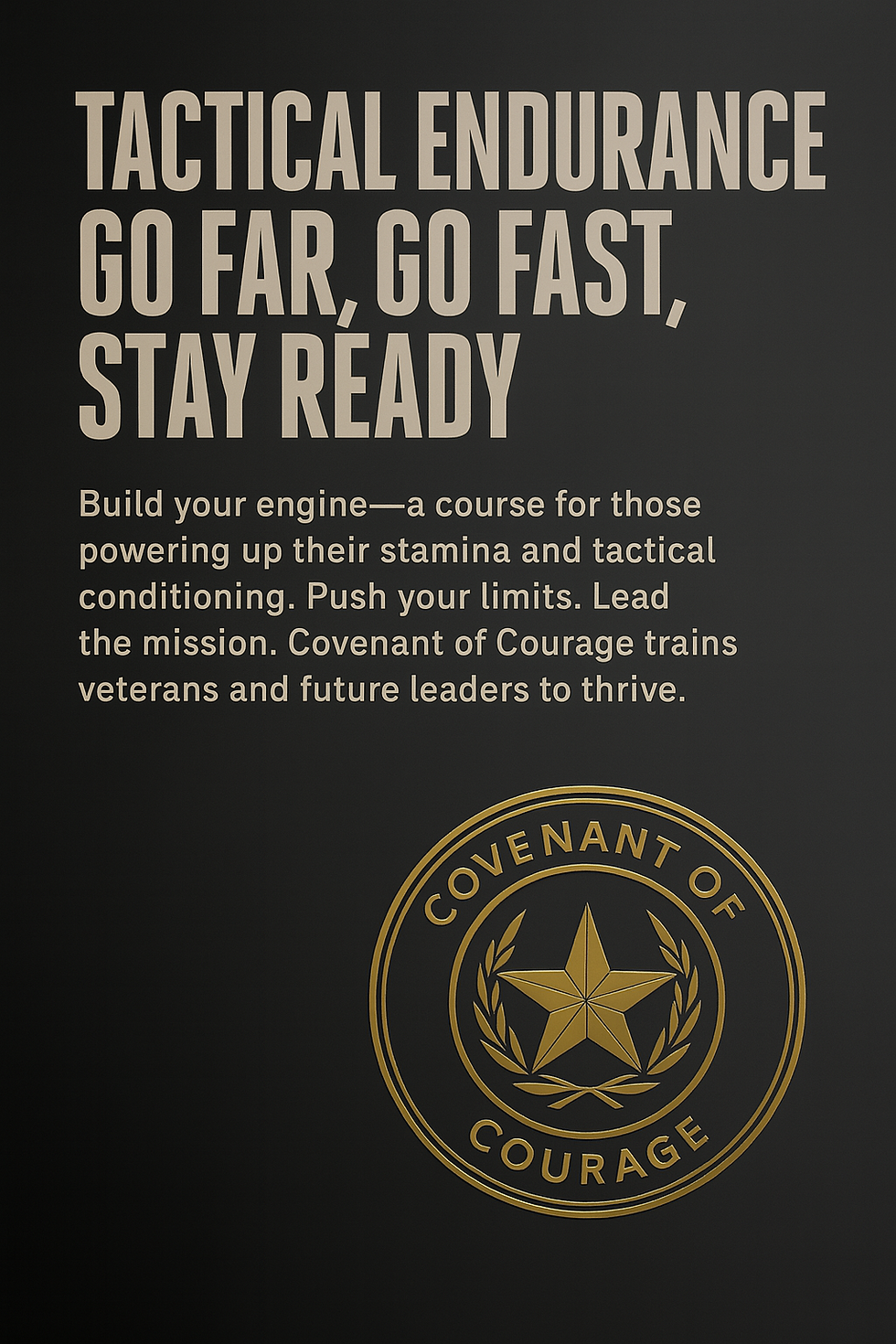🛡️ Build the Engine (Baseline Conditioning) Theme: Develop your base. Before you go fast, build your fuel tank.
- Kirk Carlson
- Jul 10
- 3 min read

By Covenant of Courage
In the world of tactical training—whether for military service, disaster response, or leadership under pressure—there’s one foundational truth:
Speed without stamina breaks down.
You don’t launch a mission on fumes. You don’t sprint into chaos without building your base. That’s why Lesson 1 of the Tactical Endurance course focuses on what we call “Building the Engine”—developing cardiovascular capacity, sustainable movement patterns, and mental grit.
This isn’t about running faster. It’s about going farther, longer, and with purpose.
🔬 Key Topics Covered:
🫁
VO₂ Max & Aerobic Capacity
VO₂ max is your body’s ability to utilize oxygen efficiently during sustained activity. The higher your aerobic capacity, the longer you can move without fatigue—and the more effective you are under pressure. Tactical operations, wildland firefighting, and long shifts in body armor all demand a robust engine.
Goal: Improve oxygen utilization through progressive endurance work and time-under-load.
🗣️
The “Conversation Pace” Explained
Training at a “conversation pace” means moving at a level where you can still talk without gasping. It’s not glamorous, but it’s gold. This aerobic zone develops long-term stamina and recovery speed.
Drill Application: Use jog/walk intervals where cadets can monitor breathing and speech ability to stay in the optimal zone.
⏱️
Tactical 2-Mile Timed Run
The 2-mile run is the gold standard across military fitness assessments. But we don’t just run for time—we run for context. This test evaluates recovery, pace control, and post-run form.
Why it matters: In tactical settings, how fast you can move when needed—and recover quickly—can be the difference between success and failure.
🧠
Breathing Techniques Under Load
Breathing is your power source. We teach controlled breath patterns tied to foot cadence:
Inhale 2–3 steps
Exhale 2–3 steps
As intensity rises, so does your breathing rate. Tactical breathing keeps your mind calm and your movement efficient.
Bonus: Learn to reset your nervous system mid-march with deep breathing drills and static holds.
🧍♂️
Static Hold + Distance Drills
Whether holding a plank under time pressure or pausing mid-ruck, static holds condition your mind and body for the rigors of real-life endurance—where there are no breaks unless you earn them.
Tactical benefit: Increases posture discipline, core activation, and control in fatigued states.
🏃♂️ Core Drills for Week 1
🎯
3-Mile Ruck with Time Intervals
Cadets carry weighted packs and alternate pace every 6 minutes. This simulates mission-based effort and recovery.
🕺
Cadence Jogs
Low-intensity jogs in rhythm, focusing on breath control, even footfalls, and group cohesion.
🧗
Hill Marches
Uphill work builds glutes, hamstrings, heart rate control, and willpower. The goal isn’t speed—it’s unbroken movement.
🔄
Tactical Jog/Walk Intervals
Alternating 2 minutes of jogging with 1 minute of walking across long distances reinforces pacing while preparing for prolonged activity in gear.
🔚 Final Word: Build Before You Burn
You can’t bypass the base. Before speed, before power, before flashy Instagram workouts—you build your engine. Because real-world missions don’t care how fast you start. They care whether you can keep going when it matters most.
At Covenant of Courage, we train leaders, veterans, and future warriors to build smart, serve strong, and endure with purpose.
Next Up: Lesson 2 – “Move with Load: Endurance Under Burden.”
📩 Interested in joining the program or partnering with us?
Contact: support@ReasonableRanks.org
Sign the petition: https://chng.it/5yXYvkBtMR





Comments